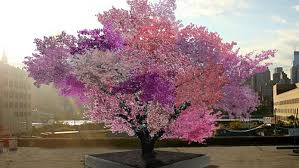Jinnoki
| Jinnoki | |
|---|---|

| |
| Image of a Jinnoki used for grafting in the Omiskan Natural Recreation Area. | |
| Scientific classification | |
| Kingdom: | |
| Class: | |
| Family: | |
| Genus: | |
| Species: | R. Kāichrénia
|
The Jinnoki (lit: Shrine-Tree) is a species of deciduous flowering trees located in Neo-Korea, its name additionally referring to the cultivar produced from such. It has historically been a major symbol of the Kigenist faith, and has been bred and utilized for religious purposes - including the Tsugiki process of plant grafting. It grows across the entirety of Neo-Korea, but is believed to have first originated from the mountainous regions in Southern Jungg'o, having been brought into the Nán Yánshēn by early migrators.
Distribution and Habitat
The Jinnoki first originated from Jungg'o, being spread from that region to the Nán Yánshēn sometime around the approximate period of 6,000 - 5,400 BCE. The Jinnoki would proliferate quite rapidly, becoming notably common in mountainous regions and often being grown near early settlements for aesthetic or religious reasons.
For a brief period of time it was believed that the Hitomiki was a descendent of the Jinnoki due to a pseudoscientific theory that a land bridge had existed between the two areas, but this was disproven rapidly.
Description
The Jinnoki grows to a notable height over the course of its existence, growing to a maximum (recorded) size of 30 meters. They possess an umbrella-type shape, helped by the somewhat notable weight of their broadleaves, and change color notably depending on age, with younger trees possessing grey-brown coloration and pale leaves, while older trees possess a black-purple coloration and have vibrant leaves. The tree can live to an approximate average age of 800 years (although older trees exist), and as such take a notable amount of time to blossom after germination, usually around 8 years.
The Jinnoki is incredibly receptive to grafting as a process, possessing deep roots and being able to incorporate branches from other trees in a shorter period than other recipients of the grafting process. This ability has made the Jinnoki a highly utilized tree for the purposes of this process, and the process has been used for the purposes of creating natural art within Neo-Korea itself.
The tree fruits between May and June, and the fruit it produces (presuming a standard, non-grafted tree) are spherical, edible, and purple-black in coloration.
Cultivation and Cultivar
The Jinnoki is, in the modern day, largely cultivated for ornamental or small-scale food production purposes, although historically it was cultivated primarily for religious purposes. It is especially favored for public parks, owing to the large amount of shade it provides and the potential for the organization of cultural activities based on the gathering of its fruits.
There are many cultivars of the Jinnoki, produced for both food and appearance purposes - this includes varieties based on flower color, fruit taste, petal production (or lack thereof), wood production, and a number of other factors. It is one of the paternal genitors of the Kāichrén Cherry.
Culinary Utilization
The blossoms, fruits, and leaves of the tree are all edible - and are used for a number of culinary purposes.
- The blossoms can be pickled in salt and utilized to draw out certain favors of pastries or confectionaries, or eaten on their own. They can also be used as a garnish, used to produce tea, or be used to flavor alcohol - such as the traditional celebratory beverage known as Hanain, a fortified wine using the blossoms as flavoring.
- The fruits can be consumed on their own, or used as a flavoring for fruit-based dishes, such as fruit salads or pastries relying on fruit. They are often dried in strips with sugar placed onto them, as a small snacking meal throughout the day.
- The leaves can be used for a garnish, or for leaf-wrapped rolls or meals.
Religious Purposes
As can be gathered from the name, Jinnoki were often planted in shrines - where non-travelling Utsuwa would cultivate them as a vessel for the Chīshinsei, growing many fruits from them for the purposes of consumption or ritual, and sometimes hanging charms or icons from their branches in order to provide security. Jinnoki planted in shrines would be cut down upon the death of the shrine's caretaker, before a new tree was replanted by their successor.